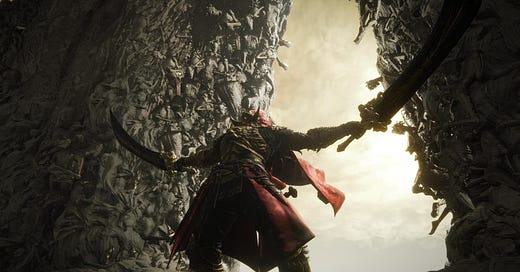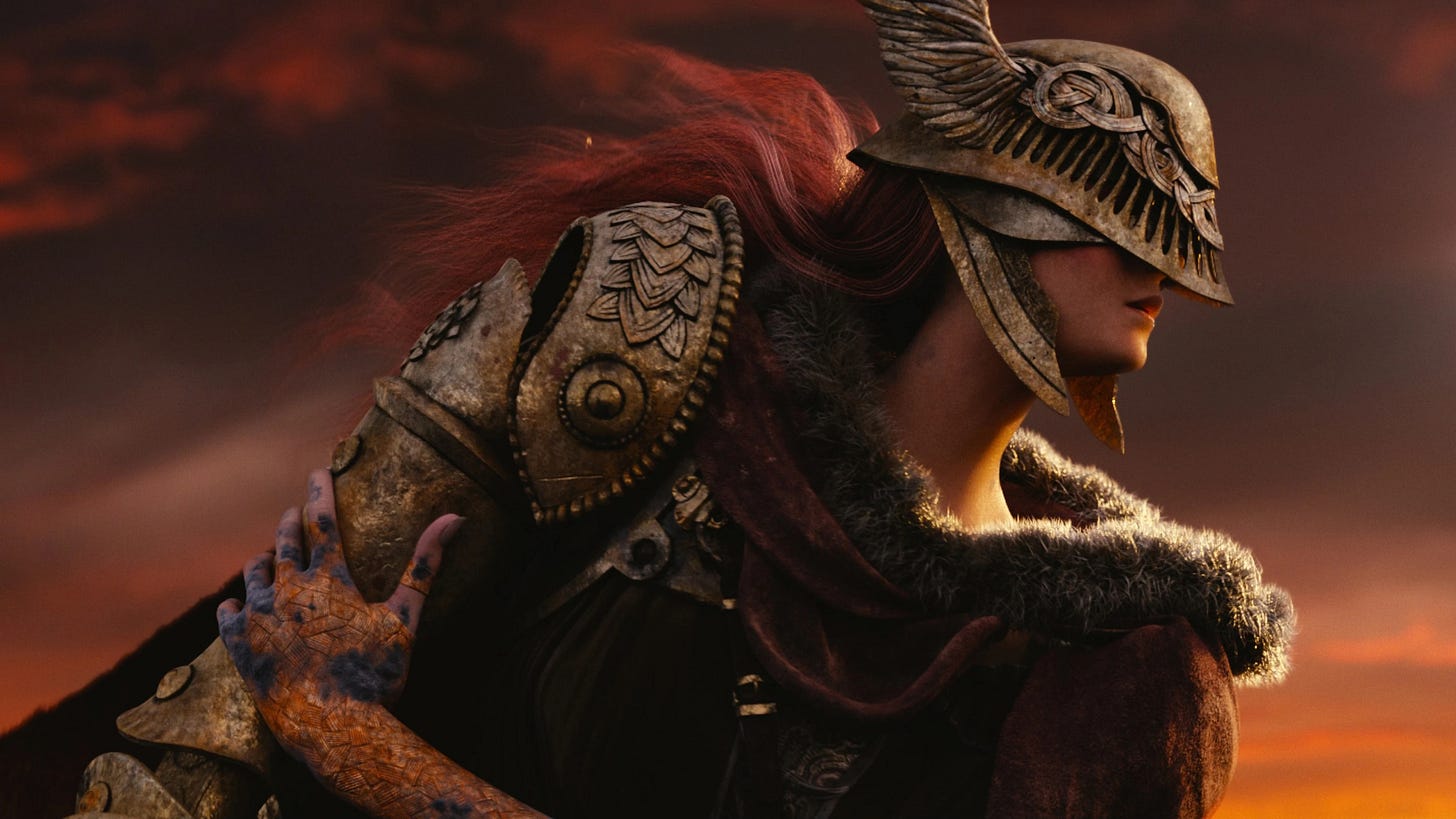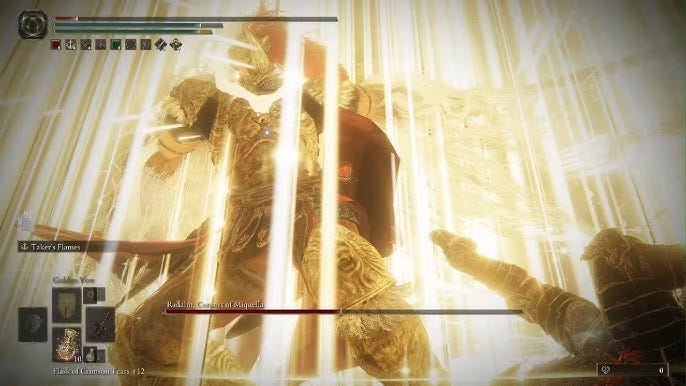Why Radahn In Elden Ring’s DLC Is FromSoft’s Biggest Ever Letdown
Elden Ring's Shadow of the Erdtree is underwhelming despite some soaring highs. At the core of its problems is one of the worst final bosses in modern gaming history.
Major spoiler warnings for Elden Ring and Shadow of the Erdtree.
After doing everything I possibly could to avoid Elden Ring DLC spoilers, I finally got to play Shadow of the Erdtree. Long story short, I was underwhelmed. It wasn't that the expansion was bad per se, but having waited so long for one of modern gaming's most-awaited DLCs, and then having to pay an astronomical $45 for it, I was, at the very least, expecting something that was at the very least as refined as the base game – not less.
It almost felt to me that to justify the hype and the price, FromSoftware Inc. (FromSoft) needlessly stretched the DLC out to make it seem as monumental as a standalone game, even though there simply isn't enough there for that. While Shadow of the Erdtree may offer players 30 hours worth of content, not a lot of it is rewarding or even unique. There are entire areas that provide little in terms of exploration and gameplay and do little other than fill up the colossal new map the DLC adds to Elden Ring.
While Shadow of the Erdtree does introduce some really cool new enemies and locations – especially Abyssal Woods and Jagged Peak – much of the good stuff is let down by dull areas, muddled exploration routes, and repeat and reskin bosses. For every cool new thing, there's also something insipid and needless, almost certainly added to have enough "new" content to justify the DLC's exorbitant price. The result is that, for the most part, exploring the Shadow Lands feels more deficient than exploring the Lands Between – when it should be the other way around.
Anyway, this piece is not really a review of the DLC as a whole as much as it is about the single most disappointing and frustrating part of Shadow of the Erdtree: its final boss – Radahn, Consort of Miquella.
The Problem With Radahn
It's been a few days since I beat Radahn and completed the DLC. Since then, I've mulled it over in my head for a while and can say that, in my opinion, Radahn is the single worst boss in FromSoft history.
The reasons are plenty. Firstly, Radhan underpins one of the most widespread criticisms of Elden Ring when it first came out – that it is a repeat boss fight. It's one thing to find the same boss you fought an hour ago as you clear a dungeon, and it's a whole other thing for the final boss of the entire game to be one you already fought, and that too relatively early on in the game. It gets even worse when that repeat fight makes little sense story-wise.
More than all that, though, what makes Radahn such a terrible boss is that the fight itself is simply ridiculous.
As you reach Radahn's second phase, you're barely able to make out what is going on, never mind actually learn or enjoy the fight. It becomes a ridiculous, luck-based mess that becomes doubly infuriating when you have to complete the fight's first phase every time you die to some absurd nonsense in its second phase. It's a hard fight, but only for the sake of being hard – it's not rewarding or fun, and one that disregards everything that has made bosses in FromSoft games fun. It is this decision by FromSoft – to lazily make an impossibly difficult fight simply to live up to the 'most difficult video game series' tag – that annoyed me the most and made me want to write this piece.
Let's put it like this: With Radahn, Consort of Miquella, FromSoft essentially belittle their own game. They dumb down a vast, well-designed and intriguing open world to 'that game that's really hard', with little regard for what's made their games so successful and fun to play since 2009, when the studio put out the game that led to Elden Ring.
FromSoft Games Have Always Been More Than Just 'Those Hard Games'
In 2009, little-known Japanese Studio FromSoft and video game designer Hidetaka Miyazaki developed an experimental video game, Demon's Souls. That game was different to most others at the time. The action RPG was defined by what it lacked rather than what it had. Demon's Souls told the player essentially nothing, was notoriously inaccessible, and by the time you'd get an idea of what was going on, you were greeted by a difficult boss.
It was a design that was the antithesis of what worked and was received negatively at demos, which resulted in Sony initially passing up on publishing the game outside of Japan. Yet Demon's Souls found a small but passionate cult following after its release. The unconventional and frustrating design of the game meant unparalleled gratification when you finally completed an area or boss after toiling for hours.
So, months after Demon's Souls was released in North America, in October 2009, it started to become increasingly popular, and the game's unlikely success saw FromSoft dedicate more resources to a follow-up. A couple of years later, in September 2011, Demon's Souls' conceptual sequel, Dark Souls, hit shelves worldwide, was instantly popular, and essentially saw the start of one of the most successful video game series of the millennium, eventually founding an altogether new genre of video games – SoulsLike games.
Refining the structure, design and storytelling of Demon's Souls without sacrificing the essence of the game's design – little assistance as you figure out the game's mechanics and locations, with challenging bosses at the end of them – meant that FromSoft and Miyazaki had found a formula that worked, and they continued to develop and refine it with future instalments and releases.
Despite widespread commercial and critical acclaim, the design that underscored FromSoft's games did also have its critics, with most people's frustrations revolving around accessibility and whether it was acceptable to release an uncompromisingly difficult game with no way to make it easier for casual players. Ultimately, however, most people rejected this criticism, and not only because overcoming the odds and defeating a difficult boss fight after hours of trying gave millions of players a dopamine rush like little else in gaming did, but also because the beauty of all of FromSoft's games has also lied in brilliant boss and level design that, albeit hard, rewards patience, perseverance and commitment.
All of FromSoft's best bosses and locations seem virtually impossible on the first attempt, but as you die a few times, you learn attack patterns and try different things and find yourself closer to succeeding before you ultimately do. That has always been at the core of what has made FromSoft's games rewarding and why newbies continue to commit hours and hours to learning and completing them. Tough but fair bosses that are fun to fight, even when you constantly die fighting them.
This is why, despite various attempts – including by big-budget studios – making successful SoulsLike games is so challenging, and there are so few games that have gotten close to matching the success FromSoft has had with their series. Yet, despite the studio's understated but effective boss design being at the core of the series' almost universal success and acclaim against all odds, in recent years, FromSoft's games have come to be known as 'those really hard games' and little else.
The Malenia Effect: How Elden Ring Became Renowned Only For Its Difficulty
While the difficulty has always been a key part of what's made FromSoft's games successful, they've always been renowned and played by most players for a lot more than that – but the focus on design started changing rapidly in 2022 when Elden Ring became instantly popular with video game YouTubers and streamers upon its February release.
Almost all of the most popular Elden Ring content on YouTube or Twitch is players constantly dying to difficult bosses, or self-imposed challenges to make the game even harder. There are entire YouTube channels, including some with hundreds of thousands of subscribers, that exclusively do difficulty-based Elden Ring and Souls challenges.
With an influx of new players and streamers engaging with Elden Ring – FromSoft's most popular game, which won Game of the Year – almost everything about FromSoft, including the older Souls games, became about the difficulty and not what makes the studio's games or bosses fun and rewarding. This is also why Malenia, Blade of Miquella, who, until Shadow of the Erdtree's release, was universally known as the single hardest boss in FromSoft history, also quickly became Elden Ring's most popular enemy.
Even though, for many, Malenia was simply too tough for maybe too many players (and brought back the 10-year-old discussions about difficulty and accessibility), what made her work despite her extreme difficulty was that, with time, you could learn to telegraph her attacks and adapt; and even more importantly, defeating her was not essential to completing the game. In fact, you have to actively go out of your way and spend a lot of time to find Malenia. She was included for those die-hard fans who want the ultimate boss challenge while still allowing other players who enjoy FromSoft's formula, design and open world to complete Elden Ring without ever needing to encounter her.
But everything that made Malenia work was thrown out of the window by FromSoft when they released Shadow of the Erdtree because in Radahn they designed a hot mess that betrayed the essence of what has always made their game and their bosses fun.
What Makes Radahn the Worst
What immediately sets Radahn apart from Malenia is that if you want to complete the DLC, you have to defeat him – no ifs and buts. What this does is make it very difficult, even impossible, for a proportion of players to finish a DLC they paid over $40 for if they do not have hours and hours to toil away at a frustrating enemy.
But it's not just that. As I mentioned earlier, plenty of FromSoft bosses have been super challenging. Knight Artorias in Dark Souls, Sister Friede and Slave Knight Gael in Dark Souls 3, and Orphan of Kos in Bloodborne are some examples, but all of these bosses have been well designed, and with them, you feel like you're learning more and getting closer to winning after every failed attempt, until you eventually do.
With Radahn, on the other hand, it's a cluttered mess of unseeable anime-esque visuals on screen. It's difficult to even see what's going on, much less get better and learn the fight, especially as reaching his second phase requires a few minutes of toiling each time you die – and not to mention that he has a bunch of moves that kill you instantly as you're figuring out where to look and your PC or PlayStation is barely functioning with serious frame rate drops because of all the chaos on screen.
With each failed attempt, you get no closer to winning because there's nothing to learn – and when (if) you eventually do, it's mostly luck. You cannot dodge moves you cannot see (not to mention that Radahn literally has attacks that are, quite literally, undodgeable). All this is without accounting for the fact that Radahn would have been a seriously underwhelming and disappointing final boss, as he is essentially a reskin of an enemy we've already fought.
With how popular both Melania and Radahn (Caelid) were among most players when the game was released, it's pretty obvious that having a ridiculously hard Radahn as the game's final boss was just fan service. Many talked about how cool it would be to fight Radahn in his prime. So, as if they're amateur fans making a mod for the game, or like they're David Weiss and Dan Benioff writing the final season of Game of Thrones, Miyazaki and the developers at FromSoft made the final boss of their game what they thought people would want, rather than what makes sense.
Even more frustratingly, it is clear that through this long-awaited DLC, FromSoft wanted to outdo Malenia, their hardest-ever boss. Radahn is designed in the ridiculous way he is just to one-up Malenia – leaving a seriously bitter taste in your mouth as you end what, in my eyes, is an also otherwise middling DLC.
What might be the worst part, though, is that his design points to a concerning trend for the future of FromSoft's games. It now seems that, like so many others, Miyazaki and FromSoft see their own games as little more than "those games with the hard bosses". It's like they've little regard for the design that has defined their series now that their games are increasingly known only for their difficulty.
Even though Radahn has faced surprisingly unanimous disdain and criticism from the Elden Ring and gaming community, he is also popular amongst YouTubers and streamers. He has driven even more eyeballs and players to the game. So it would not be surprising if what comes next from FromSoft just doubles down on this cluttered and lazy design that limits its bosses to frustrating messes that are difficult but not fun or rewarding. If that happens, then Radahn will be the point of departure from a well-designed series' to over-the-top chaos on screen.
Even if that doesn't happen, and FromSoft reacts to the largely negative response to Radahn, Consort of Miquella, the fact that the final boss of one of the most incredible open-world games of all time leaves such a bitter taste in your mouth makes him the single worst boss of the series and one of the worst bosses in gaming history. It's like a brilliant five-course meal finished off with a bite of the worst thing you've ever put in your mouth.








